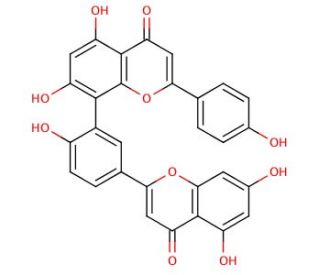

Amentoflavone (CAS 1617-53-4)
LINKS RÁPIDOS
Amentoflavona é um composto biflavonóide, constituído por duas unidades de flavona ligadas entre si. Esta estrutura única contribui para o seu amplo espetro de actividades biológicas e torna-a um tema intrigante para várias áreas de investigação científica, particularmente em bioquímica e fisiologia vegetal. O principal mecanismo de ação da amentoflavona envolve a sua capacidade de atuar como um potente antioxidante. Amentoflavona pode eliminar os radicais livres e reduzir o stress oxidativo nas células, o que é crucial para estudar os processos oxidativos e o seu impacto na saúde e no envelhecimento celular. Esta capacidade antioxidante é atribuída aos grupos hidroxilo fenólicos presentes na estrutura da flavona, que podem doar electrões para neutralizar as espécies reactivas de oxigénio. Na investigação centrada na sinalização celular e na atividade enzimática, a amentoflavona foi identificada como um inibidor de várias enzimas-chave. Inibe as fosfodiesterases, que estão envolvidas na degradação dos nucleótidos cíclicos no interior das células. Esta inibição pode levar ao aumento dos níveis de AMP cíclico e de GMP cíclico, que desempenham um papel importante na transdução de sinais e na regulação dos processos metabólicos. A amentoflavona apresenta também atividade como modulador de vários receptores e canais iónicos. Foi demonstrado que actua como antagonista não competitivo do recetor GABA-A, influenciando a neurotransmissão e a atividade neuronal.
Amentoflavone (CAS 1617-53-4) Referencias
- Amentoflavona antiviral de Selaginella sinensis. | Ma, SC., et al. 2001. Biol Pharm Bull. 24: 311-2. PMID: 11256492
- Inibição da expressão da ciclo-oxigenase-2 induzida pelo TNFalfa pela amentoflavona através da supressão da ativação do NF-kappaB nas células A549. | Banerjee, T., et al. 2002. Mol Cell Biochem. 238: 105-10. PMID: 12349896
- Amentoflavona inibe a indução da óxido nítrico sintase através da inibição da ativação do NF-kappaB nos macrófagos. | Woo, ER., et al. 2005. Pharmacol Res. 51: 539-46. PMID: 15829434
- Amentoflavona induz autofagia e modula p53. | Park, HJ. and Kim, MM. 2019. Cell J. 21: 27-34. PMID: 30507085
- As nanopartículas carregadas de amentoflavona aumentaram a eficácia da quimioterapia através da inibição do AKR1B10. | Zhao, F., et al. 2022. Nanotechnology. 33: PMID: 35697009
- Amentoflavona inibe a transição epitelial-mesenquimal do cancro colorrectal através da via miR-16-5p/HMGA2/β-catenina. | Cai, K., et al. 2022. Ann Transl Med. 10: 1009. PMID: 36267717
- Amentoflavona atenua a cardiotoxicidade induzida pela doxorrubicina, suprimindo a piroptose e a inflamação dos cardiomiócitos através da inibição da via de sinalização STING/NLRP3. | Fang, G., et al. 2023. Phytomedicine. 117: 154922. PMID: 37321078
- Amentoflavona, um potente inibidor natural da metaloproteinase 2 da matriz. | Jo, S., et al. 2023. Nat Prod Res. 1-8. PMID: 38112430
- Inibição da ligação de benzodiazepinas in vitro pela amentoflavona, um constituinte de várias espécies de Hypericum. | Baureithel, KH., et al. 1997. Pharm Acta Helv. 72: 153-7. PMID: 9204773
- Amentoflavona, uma biflavona vegetal: um novo agente anti-inflamatório potencial. | Kim, HK., et al. 1998. Arch Pharm Res. 21: 406-10. PMID: 9875467
Informacoes sobre ordens
| Nome do Produto | Numero de Catalogo | UNID | Preco | Qde | FAVORITOS | |
Amentoflavone, 1 mg | sc-214533 | 1 mg | $80.00 | |||
Amentoflavone, 5 mg | sc-214533A | 5 mg | $413.00 |
